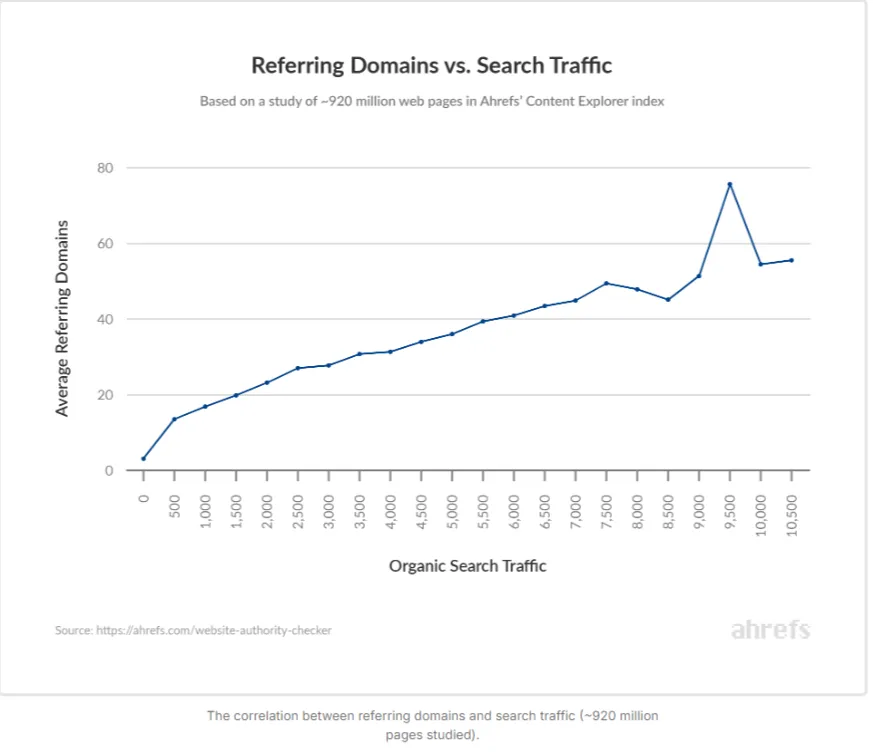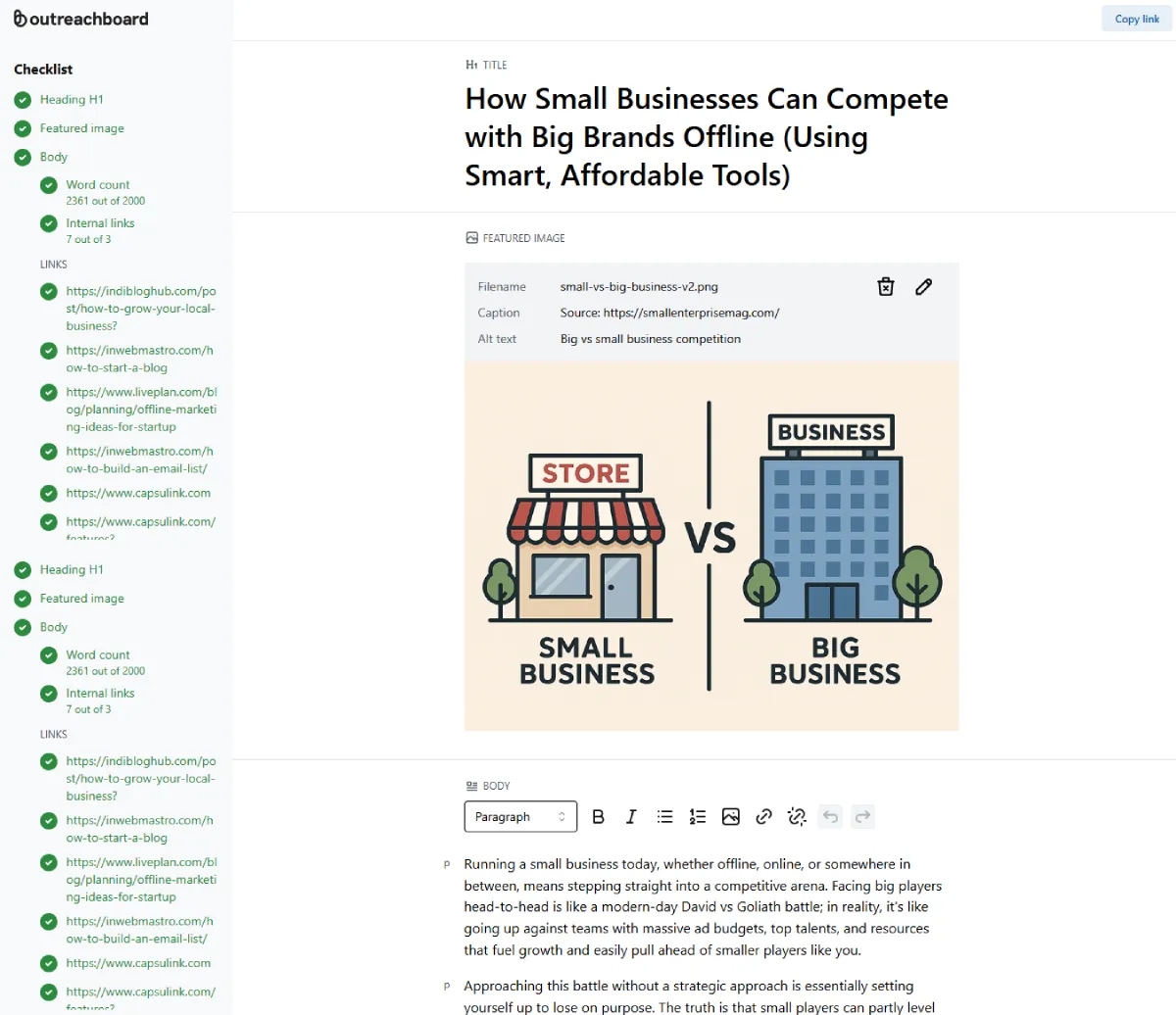How Brands and Agencies Can Scale Guest Posting and Link Building in 2025
Despite the rapid evolution of Google’s algorithms and the rise of AI-overviews, organic search traffic is still the primary source of traffic for more than 53% all websites according to SExO Inc.
Backlinks continue to play a crucial role in SEO strategy, even as Google only emphasizes quality content and user experience, both of which are essential for your long-term SEO success. Among the various ranking factors, the impact of backlinks remains one of the most clear and measurable.
Multiple studies from Ahrefs and other reliable sources consistently show the significant impacts of backlinks and their strong correlation with higher rankings and increased traffic. The data makes it clear: if you want to compete in search, you can’t ignore link building. Just take a look at the image below.

If you’re serious about competing in today’s digital landscape, link building is not an option but a ranking prerequisite, especially for brands in competitive Saas, health, and finance niches. You need systems that can scale your guest posting process to acquire backlinks more efficiently.
But first, let’s discuss the common challenges we normally face with the traditional guest posting process, which some of us are already familiar with.
Link Building Challenges: The Current State of Guest Posting in 2025
The guest posting landscape has dramatically shifted from what it used to be just a few years ago.
Today’s reality presents several critical challenges with the traditional guest posting approach, which makes changing your approach and scaling the whole process very important.
Below are the most common challenges link builders face when doing guest posting:
1. Declining Response Rates
- Cold outreach response rates have dropped to 2-5% industry-wide
- Publishers are overwhelmed with both spam and guest post requests
- Generic pitches are the fastest path to getting ignored immediately
- Building relationships now takes longer than before
2. Value Exchange Expectations
- Publishers expect value in exchange through reciprocal link insertion, guest post, or paid guest post or link insertions.
- Quality standards have risen significantly across all industries.
- Some sites may demand social media promotion with proof after publication.
3. Increased Competition
- More brands are investing in content marketing than ever
- Limited high-quality publication opportunities
- Rising costs for premium placements
- Longer wait times for publication approvals
4. Complex Publication Requirements
- Each publisher has unique submission guidelines
- Different formatting and style requirements
- Varying editorial review processes
- Multiple revision rounds are becoming standard
- Some strictly do not accept AI content
5. Tracking and Management Overhead
- Manual processes don’t scale beyond 10-20 posts monthly
- Email chains become unmanageable
- Lost submissions and missed deadlines
- Difficulty proving ROI to stakeholders
These challenges aren’t just inconveniences; they’re scaling bottlenecks that prevent most businesses from achieving their link-building potential. The solution lies in systematic approaches and smart automation.
Related Guide: Some of the Most Innovative Link Building Strategies
How to Scale Link Acquisition Through Guest Posting
Successfully scaling guest posting requires breaking down the process into manageable, systemized components.
This isn’t strictly about working harder; it’s about working smarter. The easiest way to do that is by clearly breaking the process into clear, repeatable steps you understand and can manage.
Here’s the framework that works, I strongly suggest:
1. Systematic Prospect Research and Outreach
The foundation of scaling backlinks through guest posts starts with systematic prospect research.
The first step is building a strong pipeline of publishers before outreach:
- Build prospect databases – Keep a running list of sites that accept guest posts with their contact info, audience type, and content style. Top agencies often keep hundreds of unique prospects on file or in an Excel sheet so they never run out of opportunities easily. They are not limited to sites that only publicly accept guest posting, but also any other sites that fit their target criteria.
- Automate your outreach – Instead of sending every email by hand, use 3–5 follow-up sequence templates that trigger automatically. You should automate this process, but spend a little time to still personalize every message.
- Personalize at scale – Mention a recent article, call out a theme on their blog, or highlight why your pitch fits. Templates help, but personalized authenticity wins.
- Track responses closely – Most accepted guest posts don’t come from the first email; they come after the second or third nudge. A simple tracking tool keeps you on top of follow-ups.
2. Streamlined Content Creation Process
Scaling content doesn’t mean lowering quality; it means making the process repeatable without cutting corners.
- Develop content templates and frameworks – Build templates for different content types (how-to guides, case studies, industry insights) that can be quickly customized for various publications and audiences without losing quality.
- Plan with editorial calendars – Align your content schedule with outreach. You can map themes a few months ahead so writers have time to prepare, and you never scramble at the last minute.
- Build in quality checks – Before hitting send, review each piece for SEO, accuracy, publisher requirements, and tone. A simple checklist avoids embarrassing mistakes like I’ve personally made in the past.
- Pick collaboration tools that fit – Use platforms that let writers, editors, and outreach managers work together smoothly, with real-time feedback and version control. Tools like Outreachboard can help streamline this process, and I’ll cover exactly how it works later in the post.
3. Publication Management and Tracking
Once you’re running multiple campaigns, staying organized becomes more difficult and very important.
- Keep your campaigns structured – Group them by client, theme, or time period. A clear system prevents things from slipping through the cracks.
- Track where content stands – Know instantly whether a post is in draft, under review, or live. Real-time status tracking saves endless back-and-forth.
- Monitor performance, not just placement – Measure traffic, engagement, and maybe your new DA if you value that. As an agency, this shows clients the real value beyond a simple backlink acquired.
- Measure ROI simply – Compare your investment (time, tools, fees) to the results (traffic, rank growth, leads, visibility). This will help you to refine your process on what works and prove value to your clients, like I said before.
Use Automated Tools to Manage Content Creation and Outreach
The difference between agencies struggling to manage 20 guest posts a month and those publishing 100+ consistently comes down to the type of tools they use and the systematic approach they follow.
Here’s what actually works:
1. The Outreach Board Tool
Most guest posting workflows are a mess, with emails flying around, multiple Google Docs, missing images, and security concerns about giving outsiders WordPress backend access. At this point, it looks like I’m describing myself.
It’s chaotic and easy to get caught off guard, which is exactly why I built OutreachBoard, to bring structure and sanity back into the guest posting process.

Outreach Board & How it works:
- Guest authors create content in a specialized editor with built-in pre-publishing checklists
- The system ensures authors complete essential tasks before submission:
- Adding internal links
- Optimizing images
- Inserting alt text
- Blog owners receive properly formatted content directly in their WordPress dashboard
- One-click review, edit requests, and publishing, no backend access needed for authors
Automated quality control:
- Flags missing alt text automatically
- Catches broken formatting issues
- Identifies missing internal links
- Blocks unsupported or risky file types for security
This focused tool helps teams accept, review, and publish guest content efficiently while maintaining full control over what goes live.
2. Outreach Automation
Complement your content creation process with a systematic prospect communications outreach:
Features that will help you scale outreach:
- Email sequence automation, which handles timing and follow-up scheduling
- Prospect database management will keep all communication history organized in one place
- Response tracking ensures no opportunities are missed
- Performance data helps optimize outreach messages
Reliable tools for outreach automation:
- Pitchbox – Comprehensive outreach platform with email sequences, prospect management, and detailed analytics
- BuzzStream – Relationship-focused tool with contact discovery, email templates, and campaign tracking
- Mailshake – Simple, effective cold email automation with personalization features and follow-up sequences
The combination of streamlined content creation and systematic outreach automation reduces publication time from hours to minutes while dramatically improving success rates.
Best Practices for Scaling Guest Posting
To scale guest posting effectively without losing quality, keep these best practices in place:
- Document clear workflows – Map out every step, from prospect research to final publication, with responsibilities assigned so nothing slips through the cracks.
- Set quality standards – Define your brand voice, content guidelines, technical requirements, and publisher benchmarks that protect your reputation while staying achievable at scale.
- Build the right team – Typical roles include prospect researchers, outreach specialists, writers, editors, and publication managers. Train them thoroughly on tools, processes, and quality assurance protocols, especially for agencies.
- Use tracking systems – Monitor your acquired backlinks with Moz, Ahrefs, or Semrush, or any other reliable SEO tool you are familiar with, to track your ROI, and keep visibility across campaigns and identify bottlenecks early.
- Maintain quality at scale – Combine multi-stage review processes with automated checks (for formatting, links, or alt text) where possible. Build strong publisher relationships, since scaling depends on trust as much as volume.
- Optimize based on data – Track which content types perform best, which outreach messages drive responses, and which publishers deliver the highest ROI. Continuously adjust your approach.
- Measure key metrics – Focus on acceptance and response rates, time from pitch to publication, and publisher relationship strength. For performance, track traffic, engagement, link quality, and conversions. This makes you very conscious of all that you are doing.
- Calculate ROI clearly – Measure time saved through automation, true cost per published post, long-term SEO gains (organic growth, rankings, authority), and harder-to-quantify benefits like brand mentions and industry recognition.
When all of these are implemented together, you’ll turn guest posting from a messy, time-consuming grind into a predictable, scalable growth engine.
My Final Thoughts
Brands that have mastered this process view guest posting as a systematic approach to building authority, relationships, and traffic over time.
By implementing proper scaling frameworks, leveraging automation tools, and consistently measuring your ROI and refining your process, you completely transform your guest posting approach from a time-consuming manual process into a predictable, profitable growth channel like very few agencies and brands has mastered.
IF You are Ready to Scale Your Backlink Acquisition Through Guest Posting in 2025? Then You Have to;
- Evaluate your current processes
- Implement systematic approaches to content creation and outreach
- Choose tools that eliminate manual bottlenecks
I still build backlinks to date, and understand how difficult handling the manual work looks without strong checks and balances backed by a systematic approach, it just remains difficult and ineffective.
The brands that master scaled guest posting will have a long-lasting competitive edge, as backlinks still remain one of the most reliable ranking factors in an ever-evolving digital landscape.
About the Author
Daniel is a professional content writer with 5+ years helping digital brands and agencies create content that drives measurable results. He combines audience psychology, storytelling, and SEO to turn readers into customers. Need content that converts? Get your first project free at his content writing service page.

Leave a Reply